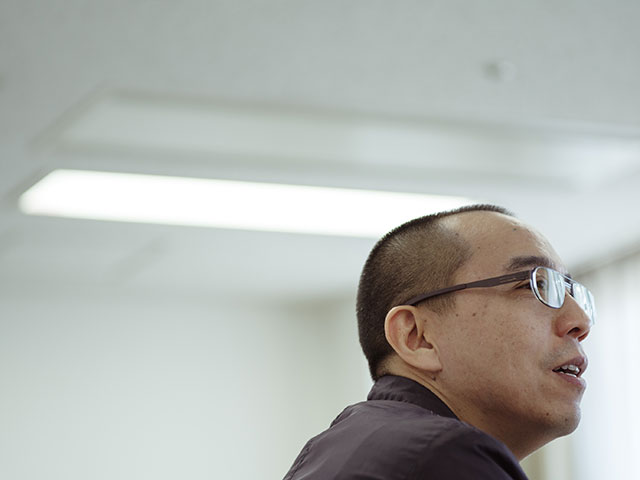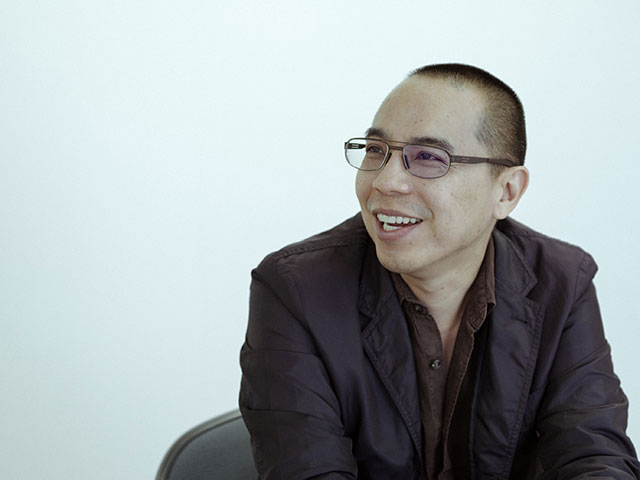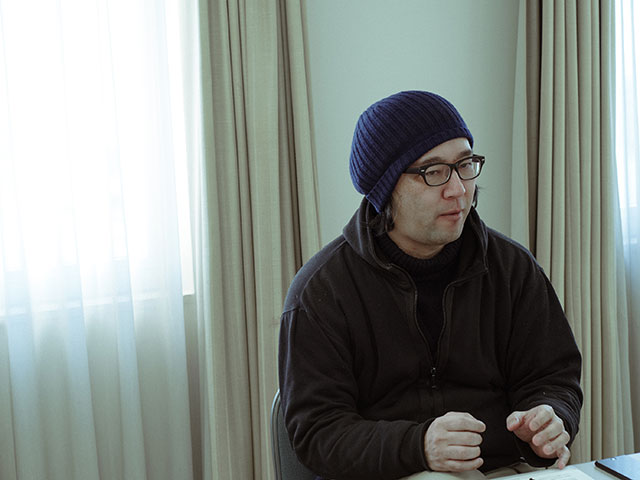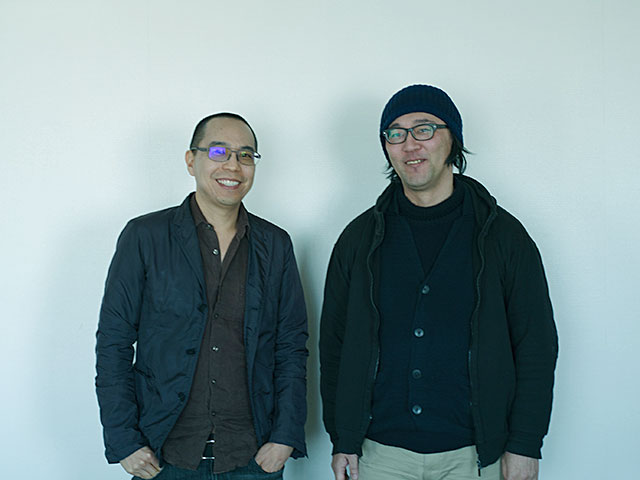The Nature of Onstage Performance
Sasaki: I would like to go back to your comment about how Fever Room came together. I watched your first performing arts work in Japan on this occasion, but there was not much information available ahead of time, and I was under the impression that the credited actors would perform on stage. The people featured in the video footage would appear on stage as if performing in a theater play, and they would blend in with the moving images. At least that was my conception of it and this was apparently what many people thought. However, everything revolved around video, right? You have created various films and artworks, and I believe you basically have a strong focus on video. Beyond video, there is the world of live performers. For example, theater, dance, or other performances involve performers, but you decided not to explore this aspect in the project. What are your thoughts on this? Do you have plans to engage in a project with live performers in the future? Or, does video play a more important role, and do you feel that performances must be converted into moving images to fit into your artistic vision.
Apichatpong: I am interested in projects that have actors perform against a background of moving images, and may produce something like that in the future. However, I can assure you that I will not be the performer as I am quite shy by nature. Even if performers are on stage, I think they can be regarded in the same way as the audience; the person that climbs on stage can be shown as part of the audience. By putting an extremely powerful projector behind the onstage performer, you can create a shadow in front of her or him, and this shadow will stretch into the direction of the audience. I can envision adopting a method where the story unfolds in the background of the stage, and the person on the stage is an audience member whose shadow expresses a feeling. I am interested in something like that.
Sasaki: That means we may see such a project at some point in the future.
Apichatpong: It is possible.
Sasaki: In Europe, for example, it is not uncommon for artists and movie directors to direct an opera or theater play. Assuming you received such a request, would you consider taking on an opera or tackling a Shakespearean play, for example? Is that something you have any interest in?
Apichatpong: I am not sure, mainly because all my work to date has been personal. In the case of Fever Room as well, my reaction to its reception has been one of happiness mixed with wonder as I discovered that many people could relate to the project. Although it is a source of great happiness, I still find it awkward. Fever Room does not have much of storyline. It has a youngster appearing, a person sleeping on a bed, and some shots of a cave. These scenes are not connected by any kind of story. For that reason, if someone were to ask me to offer my own take on a Shakespeare piece, and if I genuinely approached the work in my own style, I would imagine the Shakespearean nature of the piece would disappear. Then the question becomes whether it would appeal to the audience. This would be what would go through my mind, so it is difficult to answer the question.

About Stories
Sasaki: So far, we have covered the methodology of Fever Room. I would like to ask a few questions about the content of the story. You just mentioned Fever Room has no story, but it obviously contains fragments of storylines. The audience is watching the scenes and listening to the lines delivered by the actors from the very start, and we observe while wondering what is taking place. This is true for all your works. There is no traditional story structured into an introduction, development, turn and conclusion. However, your work repeatedly features certain motifs. I feel Fever Room brings together virtually all elements that have appeared in your previous works. It contains appearances by Jenjira Pongpas Widner and Banlop Lomnoi, both of whom have been featured repeatedly in your works. There were several lines that seem to suggest an aunt-nephew relationship between the two. I believe there was a similar dynamic in one of your previous works. You have repeatedly stated that your works are personal in nature, so I wonder if this recurring aunt-nephew relationship or motif is the starting point for many of your projects. I assume you must obviously have a reason for this or some sort of fascination with the topic. Is that the case?
Apichatpong: For me, the relationship between Jenjira and Banlop is not that of an aunt and her nephew, but that of two friends with a significant age difference.
Sasaki: She appeared like an aunt to me, but you are saying they are not related?
Apichatpong: I did not envision any family relationship; they are merely friends. My films are somewhat different from fiction. For example, Jenjira injured her leg in an accident during shooting. There are several such personal elements incorporated in the film. To give you another example, Cemetery of Splendour told the story of dreams and memories, which became the theme. These memories represent the shared memories of myself, Jenjira, Banlop, and everyone else. These have been scattered as motifs throughout the film. Then there are also the youngsters from a village in the Isan region in northeast Thailand. I used to work in that village for another project. Here I have young people who are part of a different generation appearing in the film. My main purpose is to convey and pass on memories et cetera across generations. These are the things that I deal with in my work. I am not fixated on anything in particular. In this sense, Fever Room has many similarities to Cemetery of Splendour.
Sasaki: From the outset, Fever Room and Cemetery of Splendour appear to have been twin projects. However, my impression is that we view them quite differently based on what I heard from you now.
Apichatpong: That is right. The color of the light used in Cemetery of Splendour changes constantly. This is the same for Fever Room. The story is moved forward by the changing color of the light, if I can put it that way. That is something I wanted to express in a clever way.

About the Actors
Sasaki: One of the distinguishing characteristics of your works is that they repeatedly feature the same actors such as Jenjira. You mentioned on several occasions the personal aspect of filmmaking, I suspect that after working together for a long period of time some aspects of the work can be communicated without having to spell them out into words. Is it your intention to continue working with the same people? In other words, will you continue to opt for collaborations with acquaintances or friends rather than working, for example, with professional actors or actresses who star in commercial films?
Apichatpong: I would, of course, like to continue working on projects with friends such as Jenjira and others who have worked with me for a long time. At the same time, I sometimes feel it would not be a bad idea to also introduce a few new actors or actresses. However, once you actually start working with famous people, things can get difficult. That is because they have generally accumulated experiences from past projects, and wear different masks as a result. My work has such a strong personal focus and when I work with Jenjira, I am also able to share her experiences. I am able to work at a personal level. But if I were to collaborate with famous actors or actresses, I would need them to remove their mask.
Sasaki: I see. Your focus is to express the person behind the actor or actress.
Apichatpong: In that sense, I suspect that working with famous actors or actresses would be difficult. Of course, everyone wears a mask but when I work with people, I need that mask to be as thin as possible so I can approach the real person behind it. In other words, I need them to be like a close friend. So, although there are many famous actors and actresses, I need to first be able to become their friend on a personal level before I can consider featuring them in my work.
Sasaki: I understand. It is often said that film directors coordinate or direct the performance of the actors. Can you explain what your specific approach is? I assume film directors fall into different categories: while some directors will conduct several or even a dozen rehearsals, others will simply explain the psychology behind the scene, or even ask actors to perform a scene without instructions. When I watch your works, I have a strong feeling that the actors are performing as themselves. That said, I doubt that this is the result of simply capturing them on film. In other words, I suspect that you must have some kind of special technique to achieve this. In order to express the person behind the actor, what kind of interactions do you have with, for example, Jenjira and other actors or actresses before shooting a scene? Your new film Cemetery of Splendour, which we have touched upon several times, seemed to me to have a more fully-formed story than your previous work. Does that mean that you were giving instructions to the actors and actresses as to what lines to use in each scene? Could you give us an idea of the kind of interaction you have with the actors and actresses on set?
Apichatpong: The instructions I give on set depend on the actor or actress I am dealing with. Some may have difficulty comprehending a particular scene. But one thing that they all have in common is that they trust me, so I try not to explain things in too much depth. If people are used to my method, I let them perform freely without giving instructions. For others, I have to choreograph their movements from moment to moment. It also depends on the scene that we are shooting. Some set designs and soundtracks do not require much of my input, but I may have to provide detailed explanations for others. In other words, I make decisions and change my approach on a case-by-case basis.

The Dreams and Realities of Others
Sasaki: You mentioned earlier that films emulate the dreams of other people. Your films also repeatedly include dream-related motifs. That requires people who are asleep. Both Fever Room and Cemetery of Splendour feature scenes in which a person is lying down in a hospital. A hospital is a setting where people can dream during the daytime. Whereas dreams are normally experienced at night, people admitted to hospital can dream during the daytime. I believe that dreams are such an important concept in your work that the distinction between the dream and the moving images dissolves. Is there some kind of drive or influence behind your strong focus on dreams?
Apichatpong: In my opinion, people who have an interest in films are also intrigued by dreams. I believe the human body constantly desires to dream. I have mentioned that all of my work is personal in nature, and each individual that I feature has a personal story. Dreams are an even more personal experience. So, the dreams experienced by each individual are extremely personal, and this is very profound. Accordingly, dreams themselves naturally become motifs for me. Films and dreams therefore share a connection.
Sasaki: The idea of emulating another person's dream sounds contradictory in the sense that it is impossible for people to witness the dreams of others. But film is a medium that makes this possible, am I right?
Apichatpong: That is right. My belief is that films allow us to observe the dreams of others. As I mentioned before, future advances in neuroscience will surely make it possible to share the dreams of others. However, that is still a long way off. At present, researchers are analyzing brain waves and looking at how these are connected to imagery. Such research has yet to produce reliable results and, until it does, I believe films can play an important role as a medium to witness the dreams of others.
Sasaki: I have read similar reports in the past. Although I said before that it is impossible to observe the dreams of others, I believe this will become possible in the future. And if this technology does become a reality, I wonder if we will ultimately realize that the dreams of others are not that interesting, resulting in a sense of disappointment. In our imagination we envision various possibilities, but once the technology becomes available, we may find that the personal dreams of other individuals are not all that beautiful. At least, I believe this is a possibility.
Apichatpong: That may well be the case.
Sasaki: I believe we can define the meaning of the word "dream" as moving images that are observed in the mind by a person in a sleeping state. In your work, this concept is expanded further: you depict realities that are different from the present reality; for example, previous eras, things that exist in memories, the past, et cetera. I believe an important aspect of your films is that while they reflect a reality that takes place at a specific time and place in the present moment in films, they seamlessly incorporate things that are outside of reality, exist in the past, or belong to a different time. Such scenes can be found through several of your works. Do you believe that this characteristic of not distinguishing between the dream world and reality is reflective of your own conception of dreams and your own thinking about, or acceptance, of reality?

Apichatpong: I believe dreams are seamless in nature. The point you raise about there not being any strong boundaries between dreams and reality is correct. Films feature stories that depart from reality. However, dreams can also feature the trivial and the ordinary, as well as various types of conversation. When you continue to watch these, you find that there are jumps that transcend time and space; that one moment you are observing the past and the next moment you are in the present. But the content of each individual part of the dream is not that meaningful.
Sasaki: A collection of discussions of your work was compiled in Japan last year, and I contributed an article on the theme of dreams.*1 I highlighted several examples such as the scene in which a female doctor recounts past memories in Syndromes and a Century (2006), the famous dinner scene at the start of Uncle Boonmee Who Can Recall His Past Lives (2010), or the scene in which two women travel to the Grand Palace in Cemetery of Splendour. I think an important characteristic is that these scenes are delivered naturally without any form of introduction. I guess this is what you mean by seamless, is it not? When I watched those scenes, I was wondering whether the reality I was observing was also a dream. In other words, there are various dreams existing outside of reality, and rather than the dream world creeping into reality, I felt that what I perceived as reality itself was also a dream. From this perspective, it becomes impossible to tell which parts of your films depict the reality inside the film and which parts reflect a dream. The entire film may even be a dream. After all, dreams can also feature people who are dreaming. At least, that is how I viewed it.
*1 Atsushi Sasaki, "Beautiful Dreamer," in Apichatpong Weerasethakul─An artist of light and memory" [Apichatpong Weerasethakul─Hikari to Kioku no Aatisuto], Miyuki Natsu, Yu Kaneko eds. (Tokyo: Film Art, Inc., 2016), 263–274.
Apichatpong: I am also not quite sure where the line that divides dream from reality lies. Perhaps they are in fact the same. I believe you can have the experience of seeing a film and leaving the movie theater wondering what was actually real. It is really ambiguous. They may be the same or they may merge into one another. For example, this cup filled with water is a physical object, but the reality of it will be experienced differently by different people. The process by which this cup becomes part of reality may differ for different people. The world we live in is in a state of constant flux, and the objects within it are constantly moving. In addition, the meaning assigned to things also changes with the times, and there are really no absolute certainties.

Sasaki: So, everything is always changing, or at least the possibility for change always exist.
Apichatpong: That is right. Even things that do not appear to be moving are in a constant state of flux. For example, cells cannot be seen with the naked eye, but they are constantly being regenerated. People's memories may appear to be static, but they are continually changing.
Dreams and Science Fiction
Sasaki: I just remembered something as we were discussing your worldview and your perception of reality. The other day, I visited the Apichatpong Weerasethakul: Ghosts in the Darkness exhibition held at the Tokyo Photographic Art Museum. For the installation at the entrance, there were a few paperback books showcased, and my colleagues and I assumed these must have been books that you read as a young child. The genre was science fiction, and some of the books were well-known. This observation appeared to confirm my belief that you like science fiction. As that genre deals with the study of anti-reality, is there a connection between your interests in dreams and science fiction?
Apichatpong: Both my parents were doctors so I was raised in an environment where hospitals were always in the picture. That is probably one of the reasons why I have always felt a close connection with ghosts and spirits. I have also felt there is a seamless transition between the past and the future. In addition, reading books stimulated my imagination considerably, and brought me a lot of excitement. I believe ghosts and spirits as well as UFOs are all the same in the sense that they are phenomena that depart from reality. This was my mindset when I grew up.
Sasaki: Science fiction literature has a large audience in Japan, and I am quite fond of it myself. I believe it is a very peculiar genre. Have you maintained your interest in science fiction novels, and do you still read them today?
Apichatpong: I have not read many science fiction novels as an adult. However during the science-fiction boom in the 1980s, many science fiction novels were translated and published in Thailand. At present, I have a much stronger interest in political topics than in science fiction.
Sasaki: I believe you have addressed political topics, or should I say, you've commented a great deal on contemporary political problems in your works, even in your short films. However, these are not outlined in a direct style that is easy to comprehend. My impression is that such topics are always interspersed throughout the dream. Cemetery of Splendour also contains some political elements. The fact that this tendency has grown stronger for you perhaps also points to a change in your style? I heard that you are preparing a new film. Do you think this tendency will grow even stronger? And even if it does, will you continue to avoid a straightforward discussion of the subject and instead incorporate such elements into fables or dreams? In other words, can we assume that your style will remain unchanged?
Apichatpong: I am not a political activist or expert, so I consider myself somewhat different in this respect. I am always thinking about how to convey political content from my own perspective in my work. I have two broad interests when it comes to future work. The first one is to produce a feature film that involves shooting abroad and working with foreigners, and covers broader themes. The second one is narrower in scope, and involves taking a closer look at an art-related topic. These are the vehicles through which I wish to express political aspects and social messages, and which I am currently interested in.

Future Plans
Sasaki: We have arrived at my last question. Can you share something about your future plans? For example, whether you are preparing for a feature film, or whether you have already started shooting your next project. I assume that you are working in parallel on multiple projects?
Apichatpong: Actually, I would like to shoot in South America. I am currently still gathering information and conducting research, so that project has yet to kick off. There is also the issue of fundraising and other aspects so I think it will take a little longer. I want this project to express some ideas about hallucinations and cinema.
Sasaki: I have also heard that you plan to visit Japan in July of this year.
Apichatpong: Yes, in early July I will have an exhibition called Memoria at SCAI THE BATHHOUSE. I will also participate in SUNSHOWER: Contemporary Art from Southeast Asia 1980s to Now,*2 held at the Mori Art Museum.
*2 The SUNSHOWER: Contemporary Art from Southeast Asia 1980s to Now exhibition will be held from July 5 to October 23, 2017, organized by the National Art Center, Tokyo, the Mori Art Museum, and the Japan Foundation Asia Center.
Sasaki: I see. I would like to thank you for taking such a long time out of your busy schedule to participate in this interview.

At Yokohama Sakuragicho Washington Hotel, on February 12, 2017,
Interviewer: Atsushi Sasaki
Critic. Atsushi Sasaki is also active as the director of HEADZ *Japanese Site Only, a music label, as well as the chief lecturer at Genron Sasaki School of Criticism and Theory. Sasaki teaches at several universities in Tokyo such as Waseda University, Tama Art University, and Tokyo Institute of Technology. Author of Godaru Genron [The Principles of Jean-Luc Godard] (2016), Reigai Shosetsuron (2016), Michi to no Sogu (2016), Hihyo Jikukan (2012), Nippon no Bungaku [Japanese Literature] (2016), Nippon no Ongaku [Japanese Music] (2014), Nippon no Shiso [Japanese Ideology] (2009), among others. A compilation of Apichatpong Weerasethakul's film soundtracks, Metaphors, is planned for release by HEADZ.
Interpreter: Miyako Maria Takahashi
Photo: Naoaki Yamamoto






